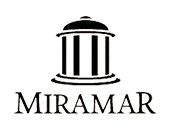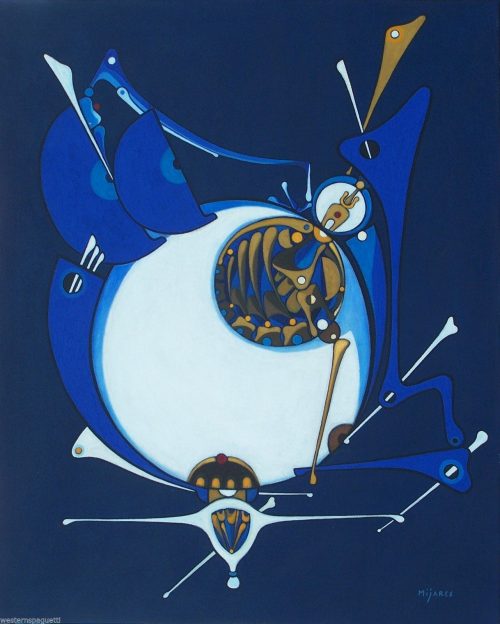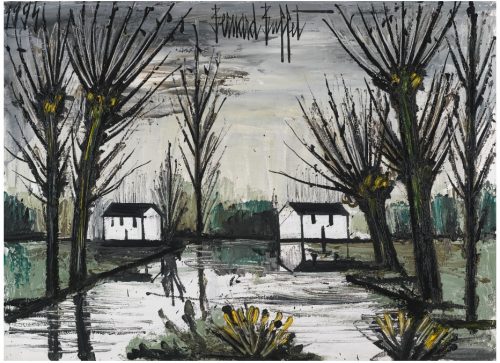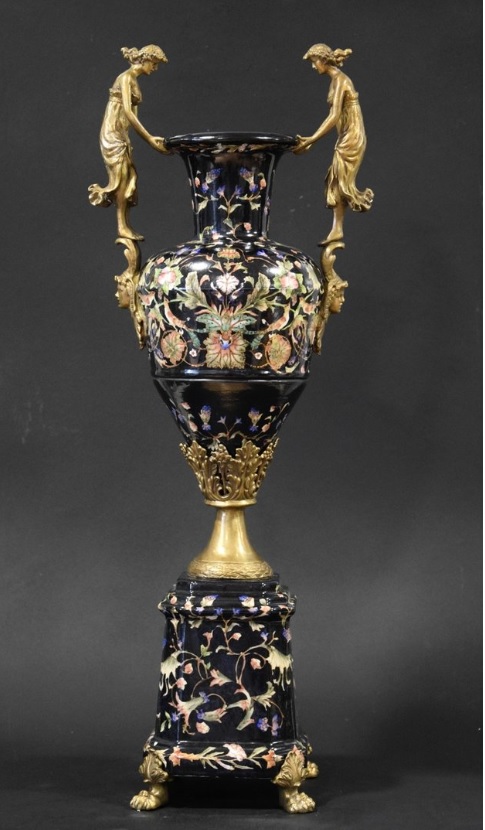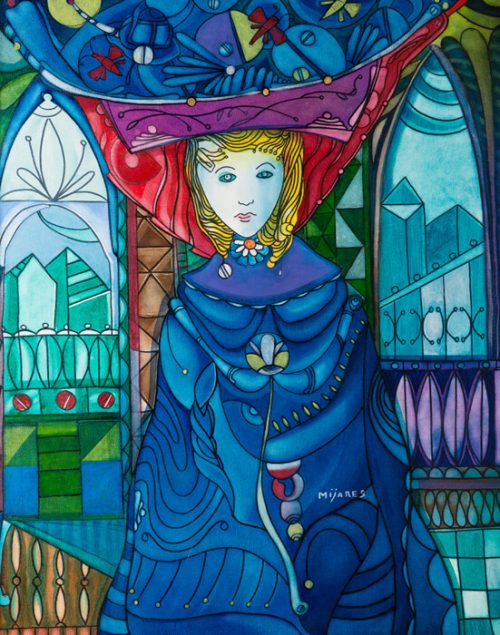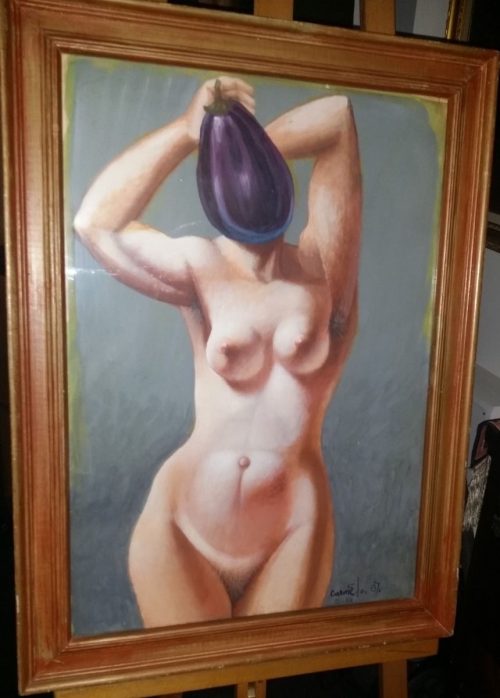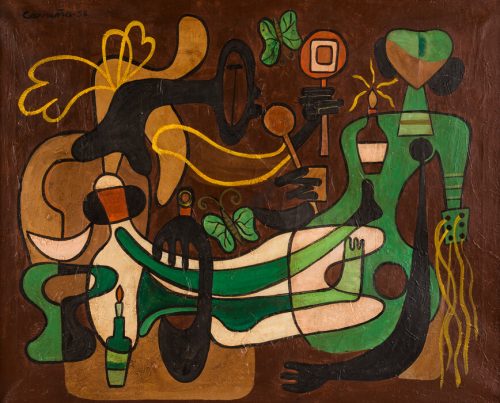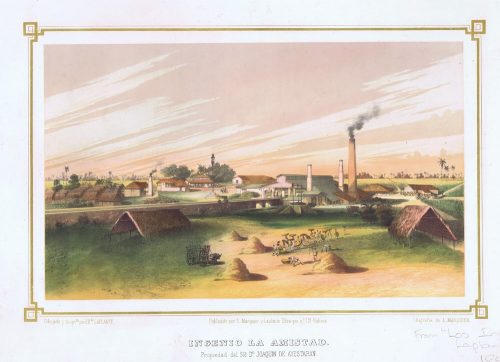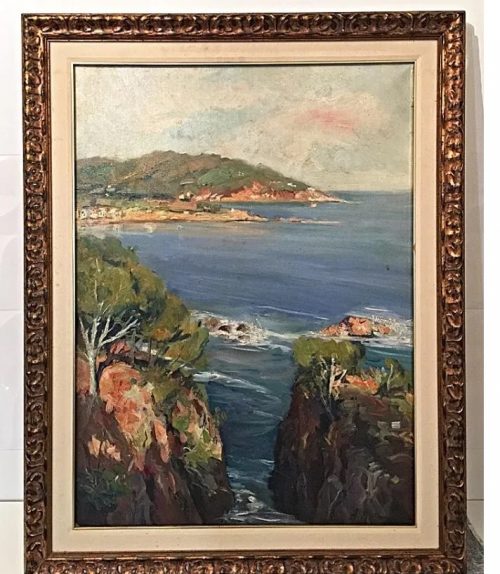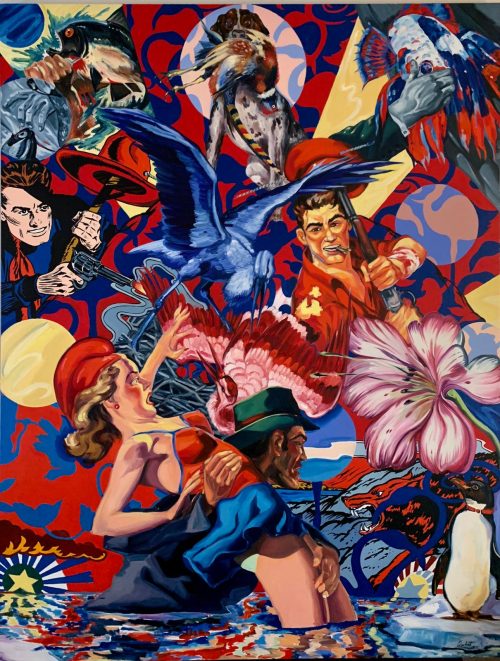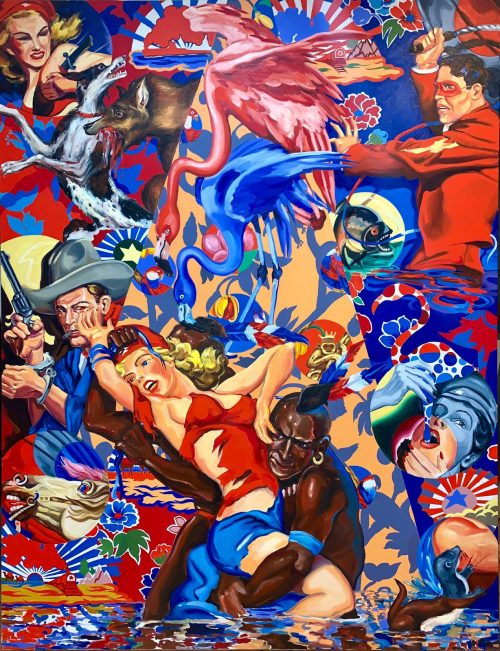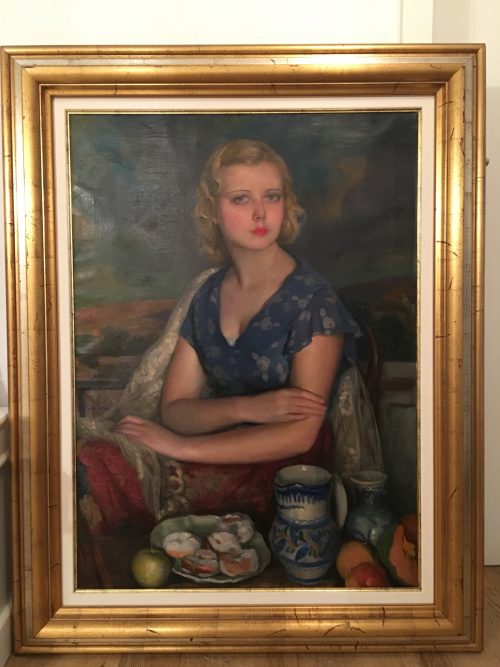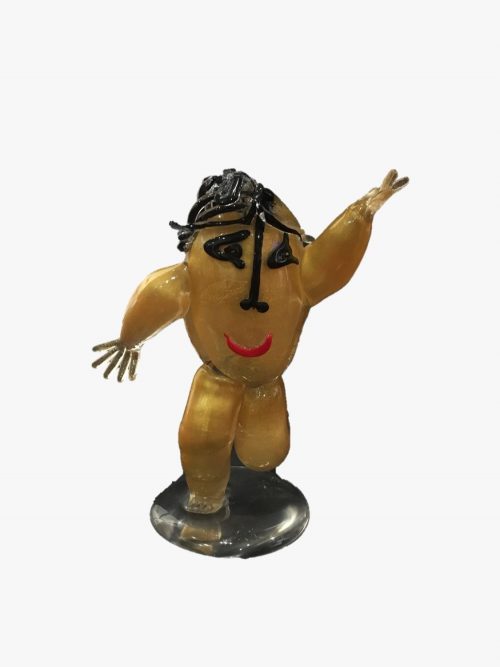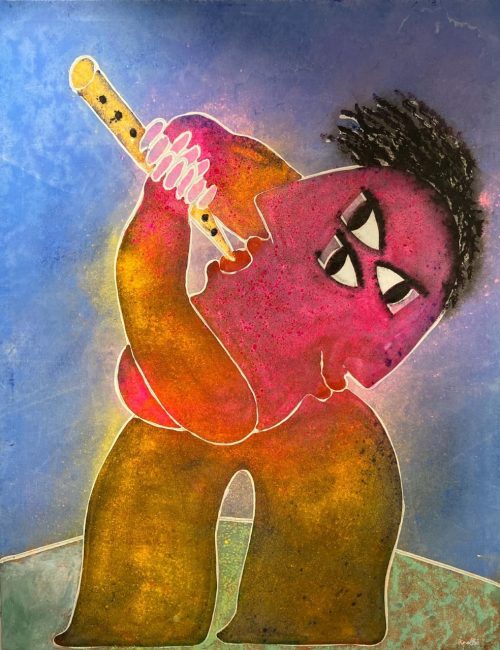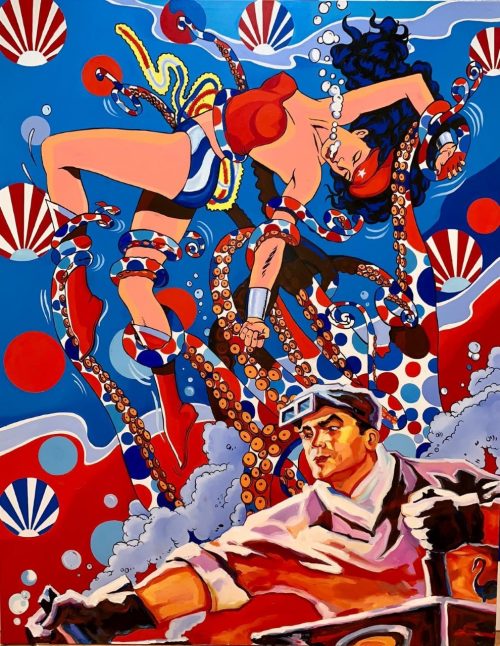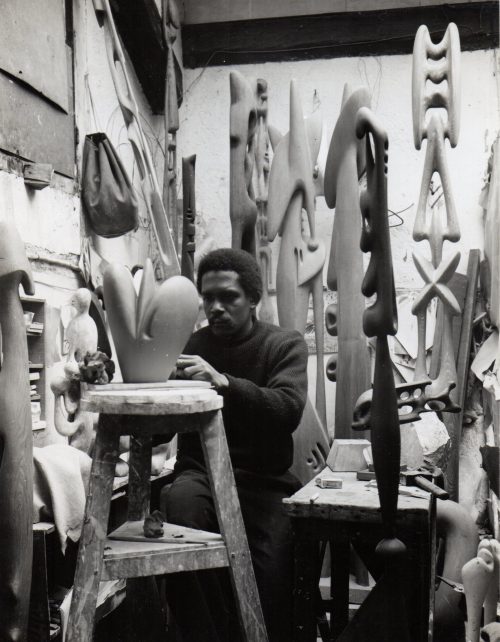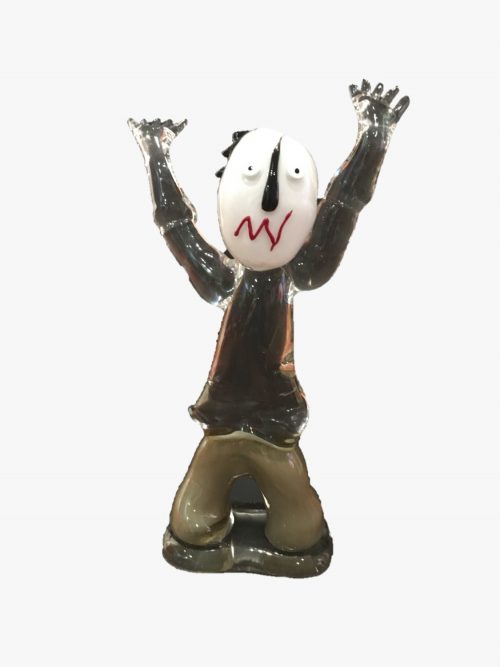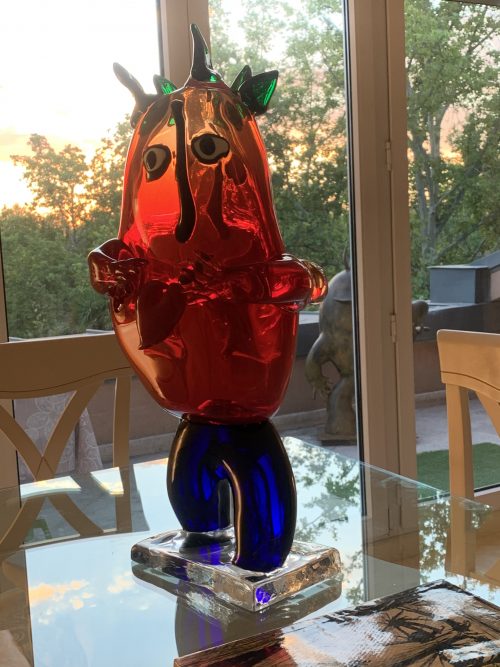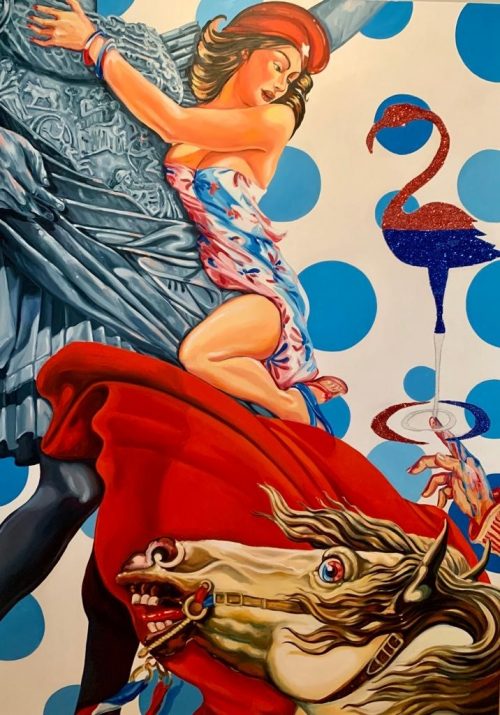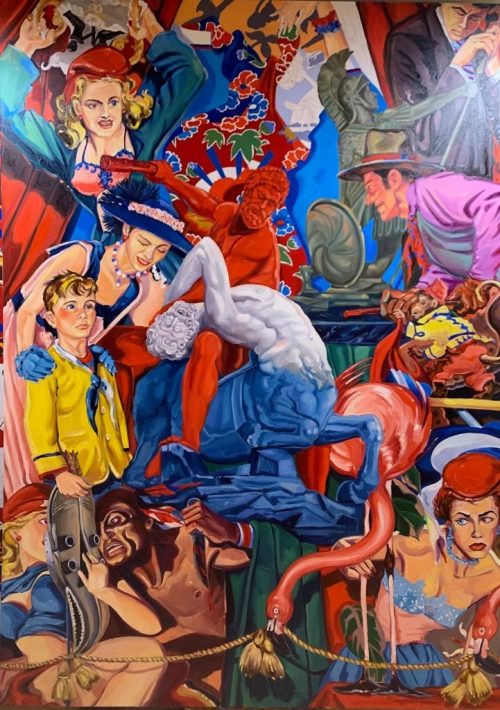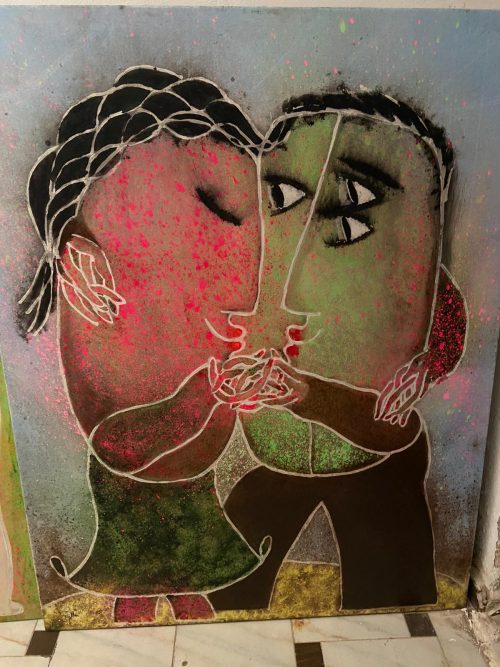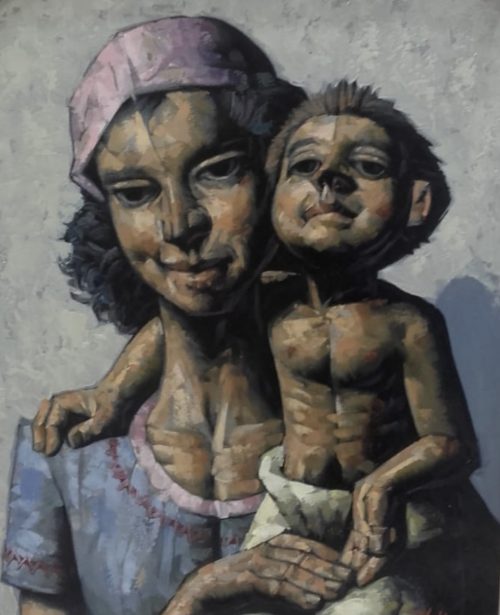-
SOLD Original frame with COA of the famous painter Jose Mijares, called LA CARACOLA. DATED 1981 SIGNED SIZE : 32 X 24 INCHES COA CERTIFICATE
-
-
Pareja de Porcelanas alemanas del siglo XIX. Porcelanas de una inigualable belleza y delicadeza. Preciosos y decorativos dos jarrónes en porcelana alemana y bronce.Dimensiones: Alto: 60 cm, ancho: 25 cm, fondo: 14 cm.
-
SOLD Original oil canvas frame by Jose Mijares. Title: Habanera. With COA and certificate. Size 30 x 24 inches. CUBAN ART. Dated 90s MIAMI BEACH (USA)
-
Excellent work by Carmelo Gonzalez. Year 1987. Size 68 cm x 47 cm. Oil on carton. Very good condition. Coa Certificate by National Museum of Bulgaria.
-
Paint by Mario Carreño, 1956 Habana (Cuba). Oil on canvas, Private collection. Title: Guateque Tropical Size: 30 x 24 inches. With COA and Certificate. Extraodinary piece. Last time exposed in exhibition in Geneva SWITZERLAND, cataloged. https://www.youtube.com/watch?v=acN383utArw&t=17s
-
A historical piece one engraving of the famous book Los Ingenios de la Isla de Cuba Title: Ingenio LA AMISTAD Year 1857 Printed in Habana (Cuba). Original engraving with Stamp. By LAPLANTE , Justo Cantero. Sugar industrial in Cuba XIX century.
-
From the famous painter Alberto Muñoz. Costa Brava Size 85 x 50 cm. On very good condition. Dated: 1945 Obra del autor Alberto Muñoz en perfectas condiciones. Oleo sobre lienzo con medidas 85x50 firmado en el ángulo inferior derecho. Año: 1945
-
Excellent original art work frame by the famous Cuban painter CIRO QUINTANA. Oil on canvas. Size 78 x 60 inches. Big size. Title: El robo de mi identidad. Ciro Quintana (b. Havana, Cuba, 1965). Founder of Puré Group, Quintana is one of the most iconic Cuban artists of the 80s. Throughout his career, his work has been exhibited at solo and group exhibitions in Cuba, the United States, Mexico, Dominican Republic, France, Germany, Peru, Venezuela, among other countries. Since 1993 he resides in Miami, Florida. https://www.youtube.com/watch?v=YPj2riBYQ80 Recent shows include: Resilience The Other Cuba (Minneapolis, 2015), Pulse Art Fair (New York, 2016),Beyond the collector Cabinet,The Rodriguez collection at Kendall Art Center(Miami2017),Scope Art Basel,Switzerland(2017),Artist of the Purgatory,Kendall Art Center(2017),Outside of Cuba,Contemporary cuban art exhibition at the Chateau Vulleriens, Switzerland (2018),Art Palm Beach Contemporary Art Fair(2018). His work is part of major collections such as, Ludwig Forum for International Kunst Collection (Aachen, Germany), National Museum of Fine Art,Havana,Cuba ,Pori Taiden Museum,(Finland), Lowe Art Museum (Miami), Fort Lauderdale Museum of Art(Latin American collection),Museum of Modern Art of Santo Domingo,Cisneros Fontanals collection ,Kendall Art Center ,Rodriguez collection(Miami), Arturo & Lisa Mosquera Collection (Miami), María Luisa Lobo Collection (Miami), Jorge Reynardus Collection (New York and Sarasota), Nina Menocal Collection (Mexico) among others.
Entering the work of Ciro Quintana is like daring behind the scenes. We attend a complex mise en scène jam-packed of scorn of which the artist makes us participants and accomplices at a time.
Ciro Quintana (Havana, 1964) is one of the cardinal artists within the second wave of the so-called Cuban Renaissance or New Cuban Art. His work, along with that of Ana Albertina Delgado, Adriano Buergo, Ermi Taño and Lázaro Saavedra, shook the artistic and social panorama of Cuba in 1986 when the iconoclastic group Puré -characterized as by kitsch, junk art, confusion between boundaries of artistic individualities and, above all, the treatment of themes directly associated with the daily and popular life of Havana at the time- broke in into Havana cultural scene. Although short-lived (the group finally disintegrated in 1987 to give way to the development of the personal poetics of its members), the impact of Puré and its bold collective actions implied a milestone in contemporary Cuban art and, consequently, in the further development of each one of the members of the group.
From very early in his artistic career, Ciro Quintana is interested in the pastiche. His works - often of an installation nature - are sophisticated visual collages. As capricious frames extracted from the most disparate films, the work of Ciro Quintana is an intricate and whimsical phrase only understandable from the reconstruction of implicit ellipses and unexpected collisions that force us to alertness. Indeed some of its top installations, such as “ Adiós a las Armas ” (Farewell to Arms), IV Biennial of Havana (collection of the National Museum of Fine Arts, Havana) and ““Pintura político-social” (Political-social painting), exhibition Kuba ok (Ludwig collection Forum for international art collection), are obliged paradigms in this regard.
Heiress direct of these works is his series “Maravillas y pesadillas del arte cubano” (Marvels and nightmares of the Cuban art), in which Ciro Quintana has been working since the year 1987. The series comprises careless collages where the kitsch survive and the initial spontaneity of the atmosphere of Puré in a sort of visual diary in which the artist collects cynically impressions of the daily life.
Ciro Quintana likes cultural clashes and semantic juxtapositions that propitiate a chain of resignifications forcing the continuous repositioning of that intrusive gaze that is the viewer who scrutinize from the proscenium. The use of the draperies and the stage in the work of Ciro Quintana function not as an element of estrangement but as an invitation to intrusion and voyeurism; Magnificent entrance door that forces us to dare into the other side of the mirror.
His iconic series “Crónicas de un artista cubano” (Chronicles of a Cuban Artist), in which Ciro Quintana has been working since 2013, is one of the artist’s most prolific series. Making use of the carnavalization, Ciro guides us behind the stage, showing us the swings of the contemporary Cuban art as a diasporic entity. For this, Ciro Quintana uses the most dissimilar symbols: Greco-Latin mythology, Renaissance painting, Flemish Baroque, Pop art, American comics, and well-rooted icons in Cuban culture such as bear, caiman, flamenco, wolf, snake, deer, and the image of the Republic, summarized in the Phrygian cap, among many others.
The substantial series, invariably performed in oil on canvas, stands out, first and above all, for its impeccable technical mastery, being just this savoir faire which allows the artist to fully develop this proposal that we could well qualify as neo-baroque.
The neo-baroque, warns the irreplaceable Severo Sarduy in his paradigmatic essay “Baroque and Neobarroco” of 1972, is characterized -as direct heir and subversion of its antecedent - by the presence of artifice (substitution, proliferation, condensation) and parody (intertextuality, intratextuality). Specific conditions that summarizes the proposal at hand. Plagued with self-referential quotations that as “filigree” connect new meanings and propose new axioms, “Crónicas de un artista cubano” is a rich pastiche where carnivalization becomes a sort of cimarronaje – by appropriating iconic fragments of Western culture that the artist “transcultura”, resignifying into a new context. If at first glance, his paintings may give the impression of a Churrigueresque incursion prompted by the horror vacui and the mere delight in tinsel and volute, it is the diachronic effect to which Sarduy refers - in that final rupture of harmony and homogeneity - where the strength of this proposal lies.
“Crónicas de un artista cubano” is a very complex skein. The proposed palimpsest comprises endless strata of significance all flattened in an abrupt foreground. This compression of the image is not gratuitous. Reflecting this “glossy skin” effect, masterfully described by Fredric Jameson, the iconographic “crush” in this series is exponent and symptom of the lack of depth that characterizes the contemporary era, saturated with images and media information whose torrent we do not reach to process but whose perennial and overflowing stream harasses us at every moment without remedy. This is the context that feeds the sophisticated feast of Ciro Quintana.
The paintings in this series emphasize the effect of theatricality (representation, artifice, parody, and unreality) to the point of incorporating the proscenium and draperies as an essential part of the scenario where the action takes place. In the foreground we witness fragmentary references to violent hunting scenes from the Flemish school of painting of the seventeenth century. The bitter struggle between predator and prey worked in chiaroscuro and generally in black and white contrasts with the colorful background where a simulated wallpaper decorated with banal motifs (flowers, flamingos, palms, and cockatoos) and treated in silhouettes of flat colors reinforces the sense of simulation and concealment that dominates the series. This relation foreground-background is not accidental: The ferocious drama we witness is trivialized by the futile decoration that strengthens the act of representation we attend. And is not this the same schizophrenic effect of the media parade of the most frightful events of the day trivialized by the irruption once and again of the sensual and sublimated adds?
Another core effect present in this series is the intertextuality that becomes intratextuality. The syntax resulting from the reckless pillaging of Western culture in this series is an act of cimarronaje that transmutes citations and appropriations into self-referentiality. Monumental hunting scenes from Flemish Baroque, inspired by Paul de Vos, in particular, his iconic piece “Deer beset by a pack of dogs” (1637-1640), appear as constant iteration throughout the series. Now the deer, now the swan, or the bird - unmistakable symbols of the defenseless prey - are devoured alive by a wild and hostile pack. The variations of this appropriation within the series are crucial clues that accentuated by the titles of the pieces function as keys for the unraveling of the chronicles narrated by this Cuban artist.
Intratextuality is also present in the recursion of the bubble that emphasizes the halo of unreality that animates this work. The bubble is used as a bridge, introducing motifs that are correlate with other works of the same series. Thus, works cannot be understood as isolated entities, forcing us all the time to the counterpoint between works that enriches the endless skein of the whole.
This effect of constant ritournelle that accentuates that aura of reality-unreality so dear to the work of Ciro Quintana is also essential to narrative structure of “Crónicas de un artista cubano”, where the central large format pieces are seconded by smaller ones (“Detalle de crónicas de un artista cubano”) that complete the meaning of the series. “Detalle de crónicas de un artista cubano” are abrupt zooms of the central paintings that as capricious windows allow us the access to parallel stories barely outlined in the central scene. Consisted of 24 “details” in total, the pieces are rotated periodically so not only spatial but temporal displacement is necessary for the total comprehension of the proposed series.
“Crónicas de un artista cubano”, refers to the sense of proliferation and chaos that typifies the contemporary era while establishing unavoidable references to the status of contemporary Cuban culture, stigmatized by its diasporic condition (the inside and outside) and the unbridled apotheosis to accompanies the boom of the current Cuban art where both, predator and prey, become victims of an useless battle.
CUBAN ART MASTER FROM SAN ALEJADRO SCHOOL. MEDIVE, FABELO, LAM, AMELIA PELAEZ, CUNDO BERMUDEZ, MARIO CARREÑO, MIJARES, MARIANO RODRIGUEZ. -
Excellent original art work frame by the famous Cuban painter CIRO QUINTANA. Oil on canvas. Size 78 x 60 inches. Big size. Title: El rapto de mi identidad. Ciro Quintana (b. Havana, Cuba, 1965). Founder of Puré Group, Quintana is one of the most iconic Cuban artists of the 80s. Throughout his career, his work has been exhibited at solo and group exhibitions in Cuba, the United States, Mexico, Dominican Republic, France, Germany, Peru, Venezuela, among other countries. Since 1993 he resides in Miami, Florida. https://www.youtube.com/watch?v=YPj2riBYQ80 Recent shows include: Resilience The Other Cuba (Minneapolis, 2015), Pulse Art Fair (New York, 2016),Beyond the collector Cabinet,The Rodriguez collection at Kendall Art Center(Miami2017),Scope Art Basel,Switzerland(2017),Artist of the Purgatory,Kendall Art Center(2017),Outside of Cuba,Contemporary cuban art exhibition at the Chateau Vulleriens, Switzerland (2018),Art Palm Beach Contemporary Art Fair(2018). His work is part of major collections such as, Ludwig Forum for International Kunst Collection (Aachen, Germany), National Museum of Fine Art,Havana,Cuba ,Pori Taiden Museum,(Finland), Lowe Art Museum (Miami), Fort Lauderdale Museum of Art(Latin American collection),Museum of Modern Art of Santo Domingo,Cisneros Fontanals collection ,Kendall Art Center ,Rodriguez collection(Miami), Arturo & Lisa Mosquera Collection (Miami), María Luisa Lobo Collection (Miami), Jorge Reynardus Collection (New York and Sarasota), Nina Menocal Collection (Mexico) among others.
Entering the work of Ciro Quintana is like daring behind the scenes. We attend a complex mise en scène jam-packed of scorn of which the artist makes us participants and accomplices at a time.
Ciro Quintana (Havana, 1964) is one of the cardinal artists within the second wave of the so-called Cuban Renaissance or New Cuban Art. His work, along with that of Ana Albertina Delgado, Adriano Buergo, Ermi Taño and Lázaro Saavedra, shook the artistic and social panorama of Cuba in 1986 when the iconoclastic group Puré -characterized as by kitsch, junk art, confusion between boundaries of artistic individualities and, above all, the treatment of themes directly associated with the daily and popular life of Havana at the time- broke in into Havana cultural scene. Although short-lived (the group finally disintegrated in 1987 to give way to the development of the personal poetics of its members), the impact of Puré and its bold collective actions implied a milestone in contemporary Cuban art and, consequently, in the further development of each one of the members of the group.
From very early in his artistic career, Ciro Quintana is interested in the pastiche. His works – often of an installation nature – are sophisticated visual collages. As capricious frames extracted from the most disparate films, the work of Ciro Quintana is an intricate and whimsical phrase only understandable from the reconstruction of implicit ellipses and unexpected collisions that force us to alertness. Indeed some of its top installations, such as “ Adiós a las Armas ” (Farewell to Arms), IV Biennial of Havana (collection of the National Museum of Fine Arts, Havana) and ““Pintura político-social” (Political-social painting), exhibition Kuba ok (Ludwig collection Forum for international art collection), are obliged paradigms in this regard.
Heiress direct of these works is his series “Maravillas y pesadillas del arte cubano” (Marvels and nightmares of the Cuban art), in which Ciro Quintana has been working since the year 1987. The series comprises careless collages where the kitsch survive and the initial spontaneity of the atmosphere of Puré in a sort of visual diary in which the artist collects cynically impressions of the daily life.
Ciro Quintana likes cultural clashes and semantic juxtapositions that propitiate a chain of resignifications forcing the continuous repositioning of that intrusive gaze that is the viewer who scrutinize from the proscenium. The use of the draperies and the stage in the work of Ciro Quintana function not as an element of estrangement but as an invitation to intrusion and voyeurism; Magnificent entrance door that forces us to dare into the other side of the mirror.
His iconic series “Crónicas de un artista cubano” (Chronicles of a Cuban Artist), in which Ciro Quintana has been working since 2013, is one of the artist’s most prolific series. Making use of the carnavalization, Ciro guides us behind the stage, showing us the swings of the contemporary Cuban art as a diasporic entity. For this, Ciro Quintana uses the most dissimilar symbols: Greco-Latin mythology, Renaissance painting, Flemish Baroque, Pop art, American comics, and well-rooted icons in Cuban culture such as bear, caiman, flamenco, wolf, snake, deer, and the image of the Republic, summarized in the Phrygian cap, among many others.
The substantial series, invariably performed in oil on canvas, stands out, first and above all, for its impeccable technical mastery, being just this savoir faire which allows the artist to fully develop this proposal that we could well qualify as neo-baroque.
The neo-baroque, warns the irreplaceable Severo Sarduy in his paradigmatic essay “Baroque and Neobarroco” of 1972, is characterized -as direct heir and subversion of its antecedent – by the presence of artifice (substitution, proliferation, condensation) and parody (intertextuality, intratextuality). Specific conditions that summarizes the proposal at hand. Plagued with self-referential quotations that as “filigree” connect new meanings and propose new axioms, “Crónicas de un artista cubano” is a rich pastiche where carnivalization becomes a sort of cimarronaje – by appropriating iconic fragments of Western culture that the artist “transcultura”, resignifying into a new context. If at first glance, his paintings may give the impression of a Churrigueresque incursion prompted by the horror vacui and the mere delight in tinsel and volute, it is the diachronic effect to which Sarduy refers – in that final rupture of harmony and homogeneity – where the strength of this proposal lies.
“Crónicas de un artista cubano” is a very complex skein. The proposed palimpsest comprises endless strata of significance all flattened in an abrupt foreground. This compression of the image is not gratuitous. Reflecting this “glossy skin” effect, masterfully described by Fredric Jameson, the iconographic “crush” in this series is exponent and symptom of the lack of depth that characterizes the contemporary era, saturated with images and media information whose torrent we do not reach to process but whose perennial and overflowing stream harasses us at every moment without remedy. This is the context that feeds the sophisticated feast of Ciro Quintana.
The paintings in this series emphasize the effect of theatricality (representation, artifice, parody, and unreality) to the point of incorporating the proscenium and draperies as an essential part of the scenario where the action takes place. In the foreground we witness fragmentary references to violent hunting scenes from the Flemish school of painting of the seventeenth century. The bitter struggle between predator and prey worked in chiaroscuro and generally in black and white contrasts with the colorful background where a simulated wallpaper decorated with banal motifs (flowers, flamingos, palms, and cockatoos) and treated in silhouettes of flat colors reinforces the sense of simulation and concealment that dominates the series. This relation foreground-background is not accidental: The ferocious drama we witness is trivialized by the futile decoration that strengthens the act of representation we attend. And is not this the same schizophrenic effect of the media parade of the most frightful events of the day trivialized by the irruption once and again of the sensual and sublimated adds?
Another core effect present in this series is the intertextuality that becomes intratextuality. The syntax resulting from the reckless pillaging of Western culture in this series is an act of cimarronaje that transmutes citations and appropriations into self-referentiality. Monumental hunting scenes from Flemish Baroque, inspired by Paul de Vos, in particular, his iconic piece “Deer beset by a pack of dogs” (1637-1640), appear as constant iteration throughout the series. Now the deer, now the swan, or the bird – unmistakable symbols of the defenseless prey – are devoured alive by a wild and hostile pack. The variations of this appropriation within the series are crucial clues that accentuated by the titles of the pieces function as keys for the unraveling of the chronicles narrated by this Cuban artist.
Intratextuality is also present in the recursion of the bubble that emphasizes the halo of unreality that animates this work. The bubble is used as a bridge, introducing motifs that are correlate with other works of the same series. Thus, works cannot be understood as isolated entities, forcing us all the time to the counterpoint between works that enriches the endless skein of the whole.
This effect of constant ritournelle that accentuates that aura of reality-unreality so dear to the work of Ciro Quintana is also essential to narrative structure of “Crónicas de un artista cubano”, where the central large format pieces are seconded by smaller ones (“Detalle de crónicas de un artista cubano”) that complete the meaning of the series. “Detalle de crónicas de un artista cubano” are abrupt zooms of the central paintings that as capricious windows allow us the access to parallel stories barely outlined in the central scene. Consisted of 24 “details” in total, the pieces are rotated periodically so not only spatial but temporal displacement is necessary for the total comprehension of the proposed series.
“Crónicas de un artista cubano”, refers to the sense of proliferation and chaos that typifies the contemporary era while establishing unavoidable references to the status of contemporary Cuban culture, stigmatized by its diasporic condition (the inside and outside) and the unbridled apotheosis to accompanies the boom of the current Cuban art where both, predator and prey, become victims of an useless battle.
CUBAN ART MASTER FROM SAN ALEJADRO HABANA SCHOOL. MENDIVE, FABELO, LAM, AMELIA PELAEZ, CUNDO BERMUDEZ, MARIO CARREÑO, MIJARES, MARIANO RODRIGUEZ. -
1926 Genuine painting by the Valencian painter VICTOR MOYA CALVO canvas painting, painter friend of ROMERO TORRES Magnificent painting by Victor Moya Calvo in oil on canvas, Size 100 cm x 80 cm measured without a frame, and is sensationally framed with a beautiful frame that is included in the sale. The live work is impressive and as he is known from the famous painter Victor Moya Calvo, a personal friend of Romero de Torres. Year 1926. His work represented in different Museums of the World and Spain. Frame in very good condition.
-
MURANO SCULPTURE BY THE FAMOUS SPANISH ARTIST JUAN RIPOLLES TITLE: La Bailarina de labios rojos. Unique piece. From the famous Murano Studio in Venezia (Italy) Size 50 cm x 23 x 20 With CERTIFICATE from the Artist. Look this video THE MURANO STORY ABOUT THE TRAVEL OF THE ARTIST JUAN RIPOLLES TO VENICE (ITALY) https://www.youtube.com/watch?v=CRfyZCLL-Rs
-
Sold- Original frame painted by the Spanish artist: Juan Ripolles Size: 150 cm x 115 cm (Big size) Signed With certificate from the artist. Frame on very good condition. https://www.youtube.com/watch?v=DJm1NerLM7s
-
Excellent original art work frame by the famous Cuban painter CIRO QUINTANA. Oil on canvas. Size 78 x 60 inches. Big size. Title: WONDERWOMAN COME BACK Ciro Quintana (b. Havana, Cuba, 1965). Founder of Puré Group, Quintana is one of the most iconic Cuban artists of the 80s. Throughout his career, his work has been exhibited at solo and group exhibitions in Cuba, the United States, Mexico, Dominican Republic, France, Germany, Peru, Venezuela, among other countries. Since 1993 he resides in Miami, Florida. https://www.youtube.com/watch?v=YPj2riBYQ80 Recent shows include: Resilience The Other Cuba (Minneapolis, 2015), Pulse Art Fair (New York, 2016),Beyond the collector Cabinet,The Rodriguez collection at Kendall Art Center(Miami2017),Scope Art Basel,Switzerland(2017),Artist of the Purgatory,Kendall Art Center(2017),Outside of Cuba,Contemporary cuban art exhibition at the Chateau Vulleriens, Switzerland (2018),Art Palm Beach Contemporary Art Fair(2018). His work is part of major collections such as, Ludwig Forum for International Kunst Collection (Aachen, Germany), National Museum of Fine Art,Havana,Cuba ,Pori Taiden Museum,(Finland), Lowe Art Museum (Miami), Fort Lauderdale Museum of Art(Latin American collection),Museum of Modern Art of Santo Domingo,Cisneros Fontanals collection ,Kendall Art Center ,Rodriguez collection(Miami), Arturo & Lisa Mosquera Collection (Miami), María Luisa Lobo Collection (Miami), Jorge Reynardus Collection (New York and Sarasota), Nina Menocal Collection (Mexico) among others.
Entering the work of Ciro Quintana is like daring behind the scenes. We attend a complex mise en scène jam-packed of scorn of which the artist makes us participants and accomplices at a time.
Ciro Quintana (Havana, 1964) is one of the cardinal artists within the second wave of the so-called Cuban Renaissance or New Cuban Art. His work, along with that of Ana Albertina Delgado, Adriano Buergo, Ermi Taño and Lázaro Saavedra, shook the artistic and social panorama of Cuba in 1986 when the iconoclastic group Puré -characterized as by kitsch, junk art, confusion between boundaries of artistic individualities and, above all, the treatment of themes directly associated with the daily and popular life of Havana at the time- broke in into Havana cultural scene. Although short-lived (the group finally disintegrated in 1987 to give way to the development of the personal poetics of its members), the impact of Puré and its bold collective actions implied a milestone in contemporary Cuban art and, consequently, in the further development of each one of the members of the group.
From very early in his artistic career, Ciro Quintana is interested in the pastiche. His works – often of an installation nature – are sophisticated visual collages. As capricious frames extracted from the most disparate films, the work of Ciro Quintana is an intricate and whimsical phrase only understandable from the reconstruction of implicit ellipses and unexpected collisions that force us to alertness. Indeed some of its top installations, such as “ Adiós a las Armas ” (Farewell to Arms), IV Biennial of Havana (collection of the National Museum of Fine Arts, Havana) and ““Pintura político-social” (Political-social painting), exhibition Kuba ok (Ludwig collection Forum for international art collection), are obliged paradigms in this regard.
Heiress direct of these works is his series “Maravillas y pesadillas del arte cubano” (Marvels and nightmares of the Cuban art), in which Ciro Quintana has been working since the year 1987. The series comprises careless collages where the kitsch survive and the initial spontaneity of the atmosphere of Puré in a sort of visual diary in which the artist collects cynically impressions of the daily life.
Ciro Quintana likes cultural clashes and semantic juxtapositions that propitiate a chain of resignifications forcing the continuous repositioning of that intrusive gaze that is the viewer who scrutinize from the proscenium. The use of the draperies and the stage in the work of Ciro Quintana function not as an element of estrangement but as an invitation to intrusion and voyeurism; Magnificent entrance door that forces us to dare into the other side of the mirror.
His iconic series “Crónicas de un artista cubano” (Chronicles of a Cuban Artist), in which Ciro Quintana has been working since 2013, is one of the artist’s most prolific series. Making use of the carnavalization, Ciro guides us behind the stage, showing us the swings of the contemporary Cuban art as a diasporic entity. For this, Ciro Quintana uses the most dissimilar symbols: Greco-Latin mythology, Renaissance painting, Flemish Baroque, Pop art, American comics, and well-rooted icons in Cuban culture such as bear, caiman, flamenco, wolf, snake, deer, and the image of the Republic, summarized in the Phrygian cap, among many others.
The substantial series, invariably performed in oil on canvas, stands out, first and above all, for its impeccable technical mastery, being just this savoir faire which allows the artist to fully develop this proposal that we could well qualify as neo-baroque.
The neo-baroque, warns the irreplaceable Severo Sarduy in his paradigmatic essay “Baroque and Neobarroco” of 1972, is characterized -as direct heir and subversion of its antecedent – by the presence of artifice (substitution, proliferation, condensation) and parody (intertextuality, intratextuality). Specific conditions that summarizes the proposal at hand. Plagued with self-referential quotations that as “filigree” connect new meanings and propose new axioms, “Crónicas de un artista cubano” is a rich pastiche where carnivalization becomes a sort of cimarronaje – by appropriating iconic fragments of Western culture that the artist “transcultura”, resignifying into a new context. If at first glance, his paintings may give the impression of a Churrigueresque incursion prompted by the horror vacui and the mere delight in tinsel and volute, it is the diachronic effect to which Sarduy refers – in that final rupture of harmony and homogeneity – where the strength of this proposal lies.
“Crónicas de un artista cubano” is a very complex skein. The proposed palimpsest comprises endless strata of significance all flattened in an abrupt foreground. This compression of the image is not gratuitous. Reflecting this “glossy skin” effect, masterfully described by Fredric Jameson, the iconographic “crush” in this series is exponent and symptom of the lack of depth that characterizes the contemporary era, saturated with images and media information whose torrent we do not reach to process but whose perennial and overflowing stream harasses us at every moment without remedy. This is the context that feeds the sophisticated feast of Ciro Quintana.
The paintings in this series emphasize the effect of theatricality (representation, artifice, parody, and unreality) to the point of incorporating the proscenium and draperies as an essential part of the scenario where the action takes place. In the foreground we witness fragmentary references to violent hunting scenes from the Flemish school of painting of the seventeenth century. The bitter struggle between predator and prey worked in chiaroscuro and generally in black and white contrasts with the colorful background where a simulated wallpaper decorated with banal motifs (flowers, flamingos, palms, and cockatoos) and treated in silhouettes of flat colors reinforces the sense of simulation and concealment that dominates the series. This relation foreground-background is not accidental: The ferocious drama we witness is trivialized by the futile decoration that strengthens the act of representation we attend. And is not this the same schizophrenic effect of the media parade of the most frightful events of the day trivialized by the irruption once and again of the sensual and sublimated adds?
Another core effect present in this series is the intertextuality that becomes intratextuality. The syntax resulting from the reckless pillaging of Western culture in this series is an act of cimarronaje that transmutes citations and appropriations into self-referentiality. Monumental hunting scenes from Flemish Baroque, inspired by Paul de Vos, in particular, his iconic piece “Deer beset by a pack of dogs” (1637-1640), appear as constant iteration throughout the series. Now the deer, now the swan, or the bird – unmistakable symbols of the defenseless prey – are devoured alive by a wild and hostile pack. The variations of this appropriation within the series are crucial clues that accentuated by the titles of the pieces function as keys for the unraveling of the chronicles narrated by this Cuban artist.
Intratextuality is also present in the recursion of the bubble that emphasizes the halo of unreality that animates this work. The bubble is used as a bridge, introducing motifs that are correlate with other works of the same series. Thus, works cannot be understood as isolated entities, forcing us all the time to the counterpoint between works that enriches the endless skein of the whole.
This effect of constant ritournelle that accentuates that aura of reality-unreality so dear to the work of Ciro Quintana is also essential to narrative structure of “Crónicas de un artista cubano”, where the central large format pieces are seconded by smaller ones (“Detalle de crónicas de un artista cubano”) that complete the meaning of the series. “Detalle de crónicas de un artista cubano” are abrupt zooms of the central paintings that as capricious windows allow us the access to parallel stories barely outlined in the central scene. Consisted of 24 “details” in total, the pieces are rotated periodically so not only spatial but temporal displacement is necessary for the total comprehension of the proposed series.
“Crónicas de un artista cubano”, refers to the sense of proliferation and chaos that typifies the contemporary era while establishing unavoidable references to the status of contemporary Cuban culture, stigmatized by its diasporic condition (the inside and outside) and the unbridled apotheosis to accompanies the boom of the current Cuban art where both, predator and prey, become victims of an useless battle.
CUBAN ART MASTER FROM SAN ALEJADRO HABANA SCHOOL. MENDIVE, FABELO, LAM, AMELIA PELAEZ, CUNDO BERMUDEZ, MARIO CARREÑO, MIJARES, MARIANO RODRIGUEZ. -
Original frame by the famous Cuban Artist Adigio Benitez Gimeno Title: La fuente de los tulipanes. Size: 130 cm x 100 cm Oil on canvas https://www.youtube.com/watch?v=say095tObUI He graduated from the San Alejandro National School of Fine Arts in 1949. He began his artistic career as a political cartoonist in the publications Voz del Pueblo, Magazine Mella and Noticias de Hoy. Later he illustrated the newspapers Granma and El Habanero. During the 1950s, he made his first paintings, in which he tackled social problems and, starting with the triumph of the Revolution, made series of militiamen, welders, and women working in factories. At the end of the 60s he began to conceive drawings and paintings as if the characters were folded paper, a kind of origami, later contrasting it with appropriations of figures from universal art. He has made more than 30 personal exhibitions and participated in more than 150 collective exhibitions in Cuba, Bulgaria, Czechoslovakia, Germany, Hungary, Romania, Poland, Italy, Mexico, the United States, Russia, the Dominican Republic, Spain, among others. He is Professor of Merit at the Superior Institute of Art, Member of the National Council of the Union of Writers and Artists of Cuba (UNEAC) and Honorary President of the International Association of Plastic Arts (AIAP). Awards and Scholarships He has received the René Portacarrero Painting Prize and the UNEAC Salon, Cuba; Mention II Biennial of Committed Realism Sofia, Bulgaria; National Prize for Artistic Teaching, National Prize for Plastic Arts 2002. Acquisition Prize. National Drawing Salon, 1959, 1961- 1963. Collections His works are exhibited in: National Museum of Fine Arts. Cuba. Bacardi Museum. Santiago de Cuba, Cuba. Ignacio Agramante Museum. Camagüey, Cuba and in private collections in: Mexico, United States, Puerto Rico, England, Germany, Russia, among others.
-
Original photo of the famous Cuban Artist AGUSTIN CARDENAS In his atelier of Paris (France) Size 8 x 10 inches. On very good condition. https://www.youtube.com/watch?v=kL1fhaAAjoE
-
SOLD MURANO SCULPTURE BY THE FAMOUS SPANISH ARTIST JUAN RIPOLLES TITLE: FRIGHTENER WOMAN Sculpture: 62 x 37 x 14cm 13kg Box: 70 x 42 x 42cm 27kg Murano Crystal Unique piece. From the famous Murano Studio in Venezia (Italy) With CERTIFICATE from the Artist. Look this video THE MURANO STORY ABOUT THE TRAVEL OF THE ARTIST JUAN RIPOLLES TO VENICE (ITALY) https://www.youtube.com/watch?v=CRfyZCLL-Rs 吃惊的妇女 小型雕塑 雕塑:62 x 37 x 14 厘米 13 千克 盒子:70 x 42 x 42 厘米 27 千克 穆拉诺水晶 胡安·里波列斯是西班牙神奇的艺术星空上的瑰丽和宿望。他是公 认的“毕加索和米罗的承继者”,而由于文学与艺术不立榜次, 无论仲伯,而号称鼎立,互为辉映。我们的艺术家,既天资颖异 而又孜孜不倦、自强不息,故而在绘画、雕塑、陶制与玻璃雕艺 等诸多领域都显得卓尔不群,斐然大观。 就西方近代的民主人文主义的观点衡量,里波列斯无愧于人类精神 家园巨匠之行列—即不依仗权力或金钱,只凭藉满腔热情与毕生 精力,创造最美的旋律、文字和形象,辅佐造物,装点人间,即所 谓因心灵、毅力、业绩与奉献而伟大者。但是, 我们的西班牙艺 术大师,头上不顶受难者的光环,而是飞翔着快乐的安琪儿。当其 西班牙同胞向他献去艺苑英雄的桂冠之时,他不意为然,并淡淡地 回答道:英雄只是与懦夫现对而言而已,我既非懦夫,亦非英雄, 只是一名涉足各艺术领域的辛勤劳动者。我并不否认个人拥有一定 的社会知名度,但那不过是客观现实的产物,何况受人尊重与英雄 品格之间,还横亘一条鸿沟,不可苟同。此一番睿智而谦逊的分 析,透露的是其一贯的淳朴、平易、荣辱不惊的厚重的生活哲思与 气度。难怪
-
SOLD MURANO SCULPTURE BY THE FAMOUS SPANISH ARTIST JUAN RIPOLLES TITLE: GIRL WITH HEART AND CAT Sculpture: 71 x 36 x 33 cm 19 kg https://www.youtube.com/watch?v=CRfyZCLL-Rs Murano Crystal Unique piece. From the famous Berengo Murano Studio in Venezia (Italy) With CERTIFICATE from the Artist. Look this video THE MURANO STORY ABOUT THE TRAVEL OF THE ARTIST JUAN RIPOLLES TO VENICE (ITALY)
-
Original drawing by the famous cuban artist JUAN DAVIDTitle: IAN SMITHDated 1971Size: big sizeMASTER PIECE GENUINE by JUAN DAVIDOn good condition.FROM PRIVATE COLLECTION.All items are guaranteed to be 100% authentic.Returns: 14 day money back guarantee if item is Unsatisfactory to Buyers standards.
-
Original frame by the famous cuban artist JORGE ARCHEOIL ON MASONITE.Title: RETRATO DE LUISA CASALDated 1941Size: 76 x 61 CMMASTER PIECE GENUINE by JORGE ARCHE.PRIVATE COLLECTION.CATALOG OF CUBAN ART 2016 IN EXPOSITION.On very good condition.
-
Excellent original art work frame by the famous Cuban painter CIRO QUINTANA. Oil on canvas. Size 78 x 60 inches. Big size. Title: "Pride and Prejudice on the Cuban Art" Ciro Quintana (b. Havana, Cuba, 1965). Founder of Puré Group, Quintana is one of the most iconic Cuban artists of the 80s. Throughout his career, his work has been exhibited at solo and group exhibitions in Cuba, the United States, Mexico, Dominican Republic, France, Germany, Peru, Venezuela, among other countries. Since 1993 he resides in Miami, Florida.
-
Original oil canvas by famous artist CIRO QUINTANA CUBAN ART POP MODERN ART US MIAMI “Centauro del museo Cubano”
Excellent original art work frame by the famous Cuban painter CIRO QUINTANA. Oil on canvas. Size 78 x 56 inches. Big size. Title: “Serie Visita al museo Cubano Centauro” Ciro Quintana (b. Havana, Cuba, 1965). Founder of Puré Group, Quintana is one of the most iconic Cuban artists of the 80s. Throughout his career, his work has been exhibited at solo and group exhibitions in Cuba, the United States, Mexico, Dominican Republic, France, Germany, Peru, Venezuela, among other countries. Since 1993 he resides in Miami, Florida. -
Original frame painted by the Spanish artist: Juan Ripolles Size: 140 cm x 115 cm (Big size) Signed With certificate from the artist. COA. Frame on very good condition.
-
Original frame by the famous artist Jesus Villar. Size 46 x 38 Cm on very good condition.
